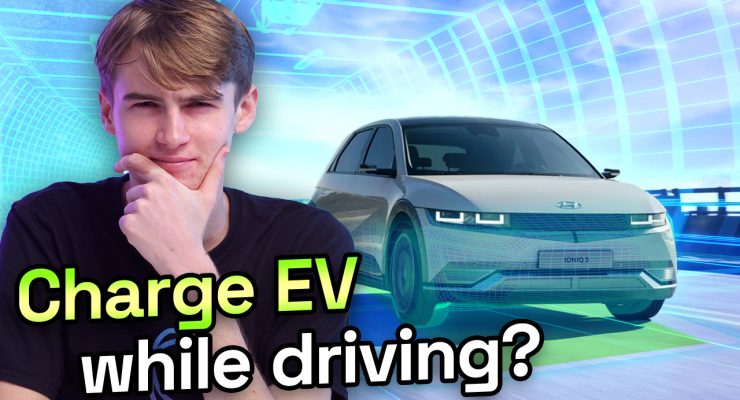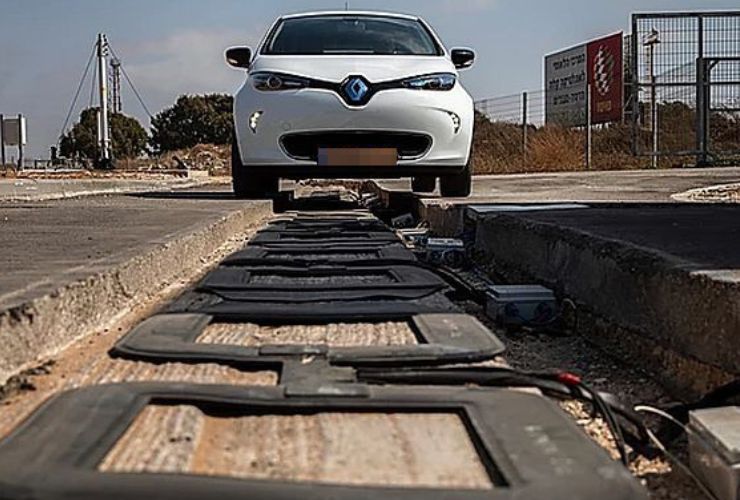
Fast read
As EVs lack an alternator like traditional cars, which can generate a current to charge the battery, it is currently not possible to charge an EV while it is in motion. Regenerative braking, however, can be used by some hybrids and plug-in hybrid electrics with batteries to charge whilst moving.
Depending on the EV, some also feature roof-mounted solar cells that can recharge the batteries whether the vehicle is in motion or parked, but the amount of energy produced is modest.
A potential future method for charging EVs while driving is wireless induction charging, which transfers electricity to a car via metal charging plates or coils under roadways.
Can I charge my electric car and drive it at the same time?
Charging an electric car while driving is a complex topic, with perspectives varying on the feasibility. The answer depends on the interpretation of the question and the specific conditions considered.
If you are confused – well, we are too because the field of electric cars is still evolving. Battery-powered electric cars, Plug-in hybrid electric cars, and Hybrid vehicles with a battery exist.
An evolving technology, a bit like VHS and Betta video recorders many decades ago, different technologies or a mix of technologies are fighting for supremacy. And don’t even let me start with hydrogen-powered vehicles, which could also be in the mix of our future transport landscape.
Although electric car technology has increased profoundly over the past few years and constantly evolves yearly, electric cars cannot charge while driving.
You may be thinking, how can a petrol car charge its battery when driving? The answer is that conventionally fuelled cars have an alternator that creates a current and sends it back to the battery while driving.
However manufacturers design EVs and petrol cars differently because electric cars do not contain a conventional engine, so they cannot use mechanical energy or an alternator.
But wait – if the EV has solar cells embedded in its roof, it can charge the batteries while parking and driving – so the answer is YES – you can charge your electric car while driving!
Now let’s look at cars with this feature in detail
The Hyundai Sonata is a plug-in hybrid vehicle with a 44 km electric car range battery, currently offering a solar roof option, too, though. But, unfortunately, with an approximate 200W roof cell capacity, such a setup will only charge about 6 km of additional driving on a sunny day.
Per annum, if the car is in, let’s say, Brisbane, this solar roof will generate 326 kWh of battery charge. This would allow you to drive about 2300 km with free yearly fuel. Also, it will save you about $400 in petrol costs per year.
As you can see, the cells look impressive on the car but don’t deliver substantial figures, so you may well ask yourself, are they just a gimmick?
Even if we manage to put cells on most of the car’s surface and solve the inverter and shading challenges, the maximum that current technology will allow is a minimal 600 – 700W solar system per car.
This will give you, on average 3kWh for a full sunny-day charge. So if this car had a 500km range and a 60kWh battery, we would have to park it in a sunny spot for 20 days to fully charge the battery via the solar cells on the car.
Per annum, such a car would give us close to 8000 km worth of free travel or about 25 km daily.

Hybrid cars can charge their batteries while driving
The car reverses every time the driver brakes the electric motor, feeding energy back into the EV battery like a generator. These are minimal charges every time, but the cumulative effect can be pretty decent. Naturally, most energy released to drive the vehicle comes from the conventional combustion engine, which forms part of this hybrid technology.
Can electric vehicles charge while driving in the future?
The main idea explored and researched recently is wireless induction charging. Much like how wireless charging is a common trend with your mobile phones, with the introduction of metal charging plates or coils under highways and main roads, EV owners may be able to charge while driving one day. Like a T2 lane on the streets, a designated charging lane may be helpful for electric vehicle owners.
So how would this work in detail?
Induction charging for your phone works by moving energy from an electric coil, a cable wound around a core, to another subject, such as the phone’s battery, through an electromagnetic field. In this instance, both subjects are stationary, which makes the job easier.
Applied to vehicles, this technology allows the electric car battery to be charged when the car parks over a prolonged time on top of a specific charging unit. Of course, for this to work, the electric vehicle has to have a receptor coil installed and aligned with the emitter coil in the pad – on top of which the electric car is parked.
The issue with this technology is – if we park for a while, we might as well plug the car into the charger and get a more efficient result with cheaper and proven technology.
The challenge is to charge the BEV while we are driving. To achieve this, we would need to develop dynamic induction charging.
The EV moves over a long series of emitter coils under the road surface in this scenario. Each time the electric car drives across the ring, it will receive a boost of charge for its battery for that split second of time. As you can imagine creating lanes with many kilometres of coils embedded in them will be extremely expensive and require a lot of copper coils.
Given the cost and CO2 generation that such infrastructure would require, I can not see this technology being rolled out into standard city streets or laneways anytime soon.
The answer is:
Therefore, as of the current technology in the electric vehicle industry, electric cars cannot charge substantially while driving; however, regenerative braking, also used in hybrid vehicles, is one way to get a little bit of extra range when going.
Nevertheless, the future could be promising for this topic, and it would not be surprising to see electric cars being able to charge while driving in a decade or so.

